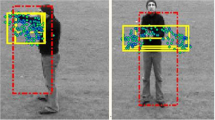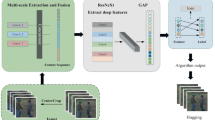Abstract
Video based human action recognition is an active and challenging topic in computer vision. Over the last few years, deep convolutional neural networks (CNN) has become the most popular method and achieved the state-of-the-art performance on several datasets, such as HMDB-51 and UCF-101. Since each video has a various number of frame-level features, how to combine these features to acquire good video-level feature becomes a challenging task. Therefore, this paper proposed a novel action recognition method named stratified pooling, which is based on deep convolutional neural networks (SP-CNN). The process is mainly composed of five parts: (i) fine-tuning a pre-trained CNN on the target dataset, (ii) frame-level features extraction; (iii) the principal component analysis (PCA) method for feature dimensionality reduction; (iv) stratified pooling frame-level features to get video-level feature; and (v) SVM for multiclass classification. Finally, the experimental results conducted on HMDB-51 and UCF-101 datasets show that the proposed method outperforms the state-of-the-art.







Similar content being viewed by others
References
Aarts E, Korst J (1988) Simulated annealing and boltzmann machines
Bay H, Tuytelaars T, Van Gool L (2006) Surf: speeded up robust features. In: Computer vision–ECCV 2006. Springer, pp 404–417
Chatfield K, Simonyan K, Vedaldi A, Zisserman A (2014) Return of the devil in the details: Delving deep into convolutional nets. arXiv:1405.3531
Chen QQ, Zhang YJ (2015) Cluster trees of improved trajectories for action recognition. Neurocomputing
Coates A, Ng AY (2011) The importance of encoding versus training with sparse coding and vector quantization. In: Proceedings of the 28th international conference on machine learning (ICML-11), pp 921–928
Donahue J, Anne Hendricks L, Guadarrama S, Rohrbach M, Venugopalan S, Saenko K, Darrell T (2015) Long-term recurrent convolutional networks for visual recognition and description. In: Proceedings of the IEEE conference on computer vision and pattern recognition, pp 2625– 2634
Fan RE, Chang KW, Hsieh CJ, Wang XR, Lin CJ (2008) Liblinear: a library for large linear classification. J Mach Learn Res 9:1871–1874
Fei-Fei L, Perona P (2005) A bayesian hierarchical model for learning natural scene categories. In: IEEE computer society conference on computer vision and pattern recognition, 2005. CVPR 2005, vol 2. IEEE, pp 524–531
Gehring J, Miao Y, Metze F, Waibel A (2013) Extracting deep bottleneck features using stacked auto-encoders. In: IEEE international conference on acoustics, speech and signal processing (ICASSP), 2013. IEEE, pp 3377–3381
Girshick R, Donahue J, Darrell T, Malik J (2014) Rich feature hierarchies for accurate object detection and semantic segmentation. In: IEEE conference on computer vision and pattern recognition (CVPR), 2014. IEEE, pp 580–587
Gkioxari G, Girshick R, Malik J (2015) Contextual action recognition with r* cnn. In: Proceedings of the IEEE international conference on computer vision, pp 1080–1088
Iosifidis A, Tefas A, Pitas I (2014) Class-specific reference discriminant analysis with application in human behavior analysis
Jain M, Jégou H., Bouthemy P (2013) Better exploiting motion for better action recognition. In: IEEE conference on computer vision and pattern recognition (CVPR), 2013. IEEE, pp 2555–2562
Jégou H., Perronnin F, Douze M, Sanchez J, Perez P, Schmid C (2012) Aggregating local image descriptors into compact codes. IEEE Trans Pattern Anal Mach Intell 34(9):1704–1716
Jhuang H, Garrote H, Poggio E, Serre T, Hmdb T (2011) A large video database for human motion recognition. In: Proceedings of IEEE international conference on computer vision
Ji S, Xu W, Yang M, Yu K (2013) 3d convolutional neural networks for human action recognition. IEEE Trans Pattern Anal Mach Intell 35(1):221–231
Jia Y, Shelhamer E, Donahue J, Karayev S, Long J, Girshick R, Guadarrama S, Darrell T (2014) Caffe: convolutional architecture for fast feature embedding. In: Proceedings of the ACM international conference on multimedia. ACM, pp 675–678
Jian M, Lam KM (2014) Face-image retrieval based on singular values and potential-field representation. Signal Process 100:9–15
Jian M, Lam KM (2015) Simultaneous hallucination and recognition of low-resolution faces based on singular value decomposition. IEEE Trans Circuits Syst Video Technol 25(11):1761–1772
Karpathy A, Toderici G, Shetty S, Leung T, Sukthankar R, Fei-Fei L (2014) Large-scale video classification with convolutional neural networks. In: IEEE conference on computer vision and pattern recognition (CVPR), 2014. IEEE, pp 1725–1732
Klaser A, Marszałek M., Schmid C (2008) A spatio-temporal descriptor based on 3d-gradients. In: BMVC 2008-19Th british machine vision conference. British Machine Vision Association, pp 275–271
Krizhevsky A, Sutskever I, Hinton GE (2012) Imagenet classification with deep convolutional neural networks. In: Advances in neural information processing systems, pp 1097–1105
Laptev I (2005) On space-time interest points. Int J Comput Vis 64(2-3):107–123
Laptev I, Marszałek M., Schmid C, Rozenfeld B (2008) Learning realistic human actions from movies. In: IEEE conference on computer vision and pattern recognition, 2008. CVPR 2008. IEEE, pp 1–8
Le QV, Zou WY, Yeung SY, Ng AY (2011) Learning hierarchical invariant spatio-temporal features for action recognition with independent subspace analysis. In: IEEE conference on computer vision and pattern recognition (CVPR), 2011. IEEE, pp 3361–3368
Le Roux N, Bengio Y (2008) Representational power of restricted boltzmann machines and deep belief networks. Neural Comput 20(6):1631–1649
Lee H, Grosse R, Ranganath R, Ng AY (2009) Convolutional deep belief networks for scalable unsupervised learning of hierarchical representations. In: Proceedings of the 26th annual international conference on machine learning. ACM, pp 609–616
Leng B, Zhang X, Yao M, Xiong Z (2015) A 3d model recognition mechanism based on deep boltzmann machines. Neurocomputing 151:593–602
Liu L, Shen C, Hengel AVD (2014) The treasure beneath convolutional layers: Cross-convolutional-layer pooling for image classification. arXiv:1411.7466
Liu R, Chen Y, Zhu X, Hou K (2015) Image classification using label constrained sparse coding. Multimedia Tools and Applications:1–15
Lowe DG (2004) Distinctive image features from scale-invariant keypoints. Int J Comput Vis 60(2):91–110
Luo J, Wang W, Qi H (2014) Spatio-temporal feature extraction and representation for rgb-d human action recognition. Pattern Recogn Lett 50:139–148
Mnih V, Heess N, Graves A, et al. (2014) Recurrent models of visual attention. In: Advances in neural information processing systems, pp 2204–2212
Peng X, Qiao Y, Peng Q, Qi X (2013) Exploring motion boundary based sampling and spatial-temporal context descriptors for action recognition. In: British machine vision conference (BMVC)
Peng X, Wang L, Wang X, Qiao Y (2014) Bag of visual words and fusion methods for action recognition: comprehensive study and good practice. arXiv:1405.4506
Peng X, Zou C, Qiao Y, Peng Q (2014) Action recognition with stacked fisher vectors. In: Computer vision–ECCV 2014. Springer, pp 581–595
Perronnin F, Dance C (2007) Fisher kernels on visual vocabularies for image categorization. In: IEEE conference on computer vision and pattern recognition, 2007. CVPR’07. IEEE, pp 1–8
Perronnin F, Sánchez J., Mensink T (2010) Improving the fisher kernel for large-scale image classification. In: Computer vision–ECCV 2010. Springer, pp 143–156
Sermanet P, Eigen D, Zhang X, Mathieu M, Fergus R, LeCun Y (2013) Overfeat: integrated recognition, localization and detection using convolutional networks. arXiv:1312.6229
Sharma S, Kiros R, Salakhutdinov R (2015) Action recognition using visual attention. arXiv:1511.04119
Simonyan K, Zisserman A (2014) Two-stream convolutional networks for action recognition in videos. In: Advances in neural information processing systems, pp 568–576
Simonyan K, Zisserman A (2014) Very deep convolutional networks for large-scale image recognition. arXiv:1409.1556
Soomro K, Zamir AR, Shah M (2012) Ucf101: A dataset of 101 human actions classes from videos in the wild. arXiv:1212.0402
Wang H, Kläser A., Schmid C, Liu CL (2013) Dense trajectories and motion boundary descriptors for action recognition. Int J Comput Vis 103(1):60–79
Wang H, Schmid C (2013) Action recognition with improved trajectories. In: IEEE international conference on computer vision (ICCV), 2013. IEEE, pp 3551–3558
Wang L, Qiao Y, Tang X (2015) Action recognition with trajectory-pooled deep-convolutional descriptors. arXiv:1505.04868
Wang P, Cao Y, Shen C, Liu L, Shen HT (2015) Temporal pyramid pooling based convolutional neural networks for action recognition. arXiv:1503.01224
Xu H, Tian Q, Wang Z, Wu J (2015) A survey on aggregating methods for action recognition with dense trajectories. Multimedia Tools and Applications:1–17
Xu K, Ba J, Kiros R, Courville A, Salakhutdinov R, Zemel R, Bengio Y (2015) Show, attend and tell: neural image caption generation with visual attention. arXiv:1502.03044
Yao L, Torabi A, Cho K, Ballas N, Pal C, Larochelle H, Courville A (2015) Describing videos by exploiting temporal structure. In: Proceedings of the IEEE international conference on computer vision, pp 4507–4515
Yue-Hei Ng J, Hausknecht M, Vijayanarasimhan S, Vinyals O, Monga R, Toderici G (2015) Beyond short snippets: deep networks for video classification. In: Proceedings of the IEEE conference on computer vision and pattern recognition, pp 4694–4702
Zhou Y, Ni B, Hong R, Wang M, Tian Q (2015) Interaction part mining: a mid-level approach for fine-grained action recognition. In: Proceedings of the IEEE conference on computer vision and pattern recognition, pp 3323–3331
Acknowledgments
This work is supported by the Nature Science Foundation of China (No.61202143, No. 61572409, No.61571188), the Natural Science Foundation of Fujian Province (No.2013J05100), the Research Foundation of Education Bureau of Hunan Province(No.15C0726).
Author information
Authors and Affiliations
Corresponding author
Rights and permissions
About this article
Cite this article
Yu, S., Cheng, Y., Su, S. et al. Stratified pooling based deep convolutional neural networks for human action recognition. Multimed Tools Appl 76, 13367–13382 (2017). https://doi.org/10.1007/s11042-016-3768-5
Received:
Revised:
Accepted:
Published:
Issue Date:
DOI: https://doi.org/10.1007/s11042-016-3768-5




